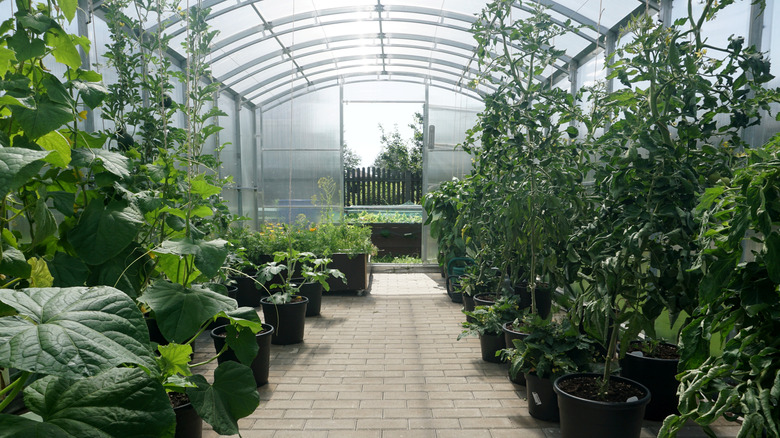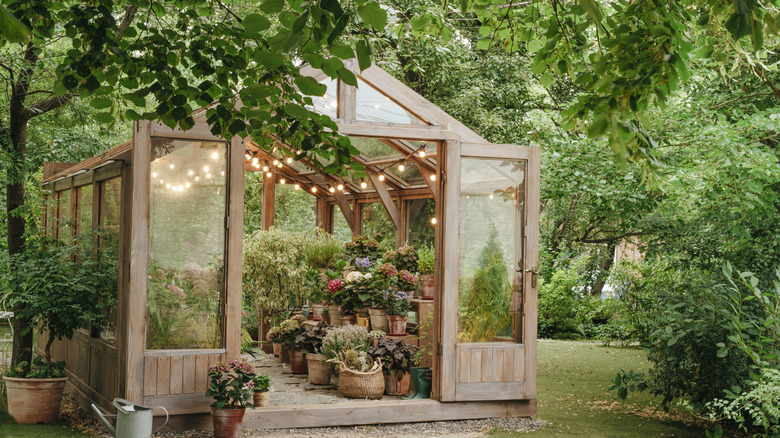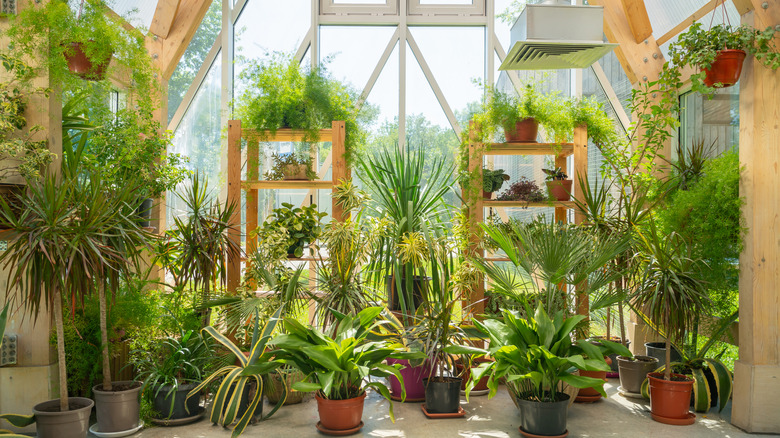Popular Flooring Solutions For A DIY Greenhouse (And Which We Think Is Best)
The last thing on your mind when planning your new greenhouse is the floor. You may be more concerned with organizing your greenhouse to maximize space or how to best use the greenhouse when you aren't actively growing plants. Either way, you probably have other things on your mind. The floor, however, is an important part of creating a nice place for you to work and your plants to grow. As Skylar Bartlett, owner at Kreer Construction, says in an exclusive interview with House Digest, "For DIY greenhouses, flooring serves multiple purposes: drainage, insulation, weed control, and easy maintenance."
There are many good options for your greenhouse flooring, and we will cover them, but if you want to fast forward to the easy answer, Bartlett says, "For most greenhouse projects, is the best overall option. It balances cost, drainage, and ease of installation while minimizing weed growth." It can shift over time and require occasional releveling, but, importantly for DIYers, Bartlett says it does not require extensive groundwork or professional installation like concrete. Still, concrete can be a good option in the right situation, as can pavers/brick, wood, compacted dirt with a weed barrier, or a permeable rubber mat.
What to consider when choosing a floor for your greenhouse
Just like so many other garden-related topics, there are a lot of very practical concerns to keep in mind. In greenhouses, drainage and moisture are key considerations, according to Skylar Bartlett. Not only will you be watering plants frequently, and undoubtedly splashing on the floor but, as she points out, "Greenhouses generate a lot of humidity, so avoiding water buildup is crucial. Materials like gravel, pavers, and permeable rubber tiles help prevent standing water."
You may also want to think about how permanent your structure will be, and the answer will impact whether you want a more long-term option like pavers or concrete. Budget may also be a factor. Bartlett tells House Digest exclusively, "Some options, like compacted dirt or wood pallets, are nearly free, while concrete or brick requires a bigger investment." Repurposing old garden pavers could also be a free option. Wood often falls victim to pests and rot so it may need to be replaced more often. Other options also require a higher level of maintenance. "Weeds, shifting surfaces, and potential mold growth are factors to consider," says Bartlett.
Finally, consider your own comfort. "If you'll be spending long hours inside, softer surfaces like rubber mats can reduce strain on your feet, while slip-resistant textures help with safety," says Bartlett. Though, you may be able to layer one of these mats on top of another more permanent surface of your choice.
The pros and cons of popular greenhouse flooring materials
Gravel wins the overall prize for being affordable, great for drainage, easy to install, and preventing weeds. Carts may have trouble with the gravel and you may need to level it once in a while, but it's a good compromise. Concrete is also a good option, especially for permanent greenhouses. As Skylar Bartlett shares exclusively with House Digest, it is "highly durable, easy to clean, [and] provides excellent stability for shelving and heavy planters. It also retains heat well, which can be beneficial in cooler months." On the other hand, it's more expensive and not as DIY-friendly. She also tells us it can be prone to cracking with temperature changes unless reinforced.
When it comes to pavers or bricks, they offer more stability than gravel, while also being aesthetically pleasing and providing good drainage. However, installation is labor intensive and they often shift over time, so avoid these mistakes when installing pavers. Wood offers a warm, natural look, and is easy to DIY, while providing insulation from the cold ground. It's also prone to rot and will require regular maintenance.
Rubber mats and permeable tiles offer a safety that most of the other options don't, as Bartlett says they are usually non-slip. They can trap moisture underneath if improperly installed, which can create mold and mildew problems. Perhaps the easiest and cheapest method is simply compacting the existing dirt and adding a weed barrier. While maintenance is simple, it can become muddy or uneven, requiring more attention.


